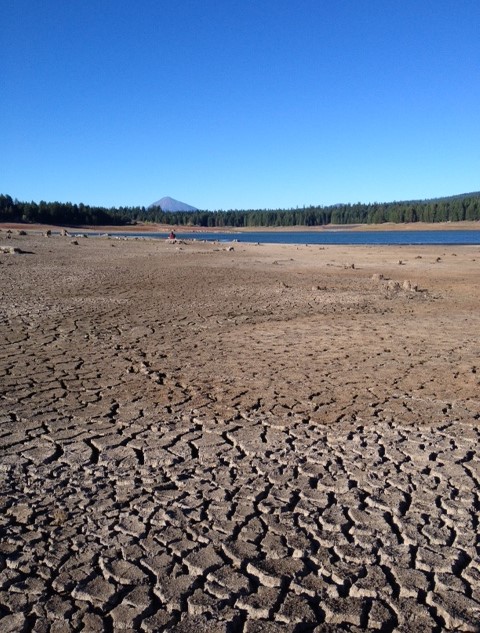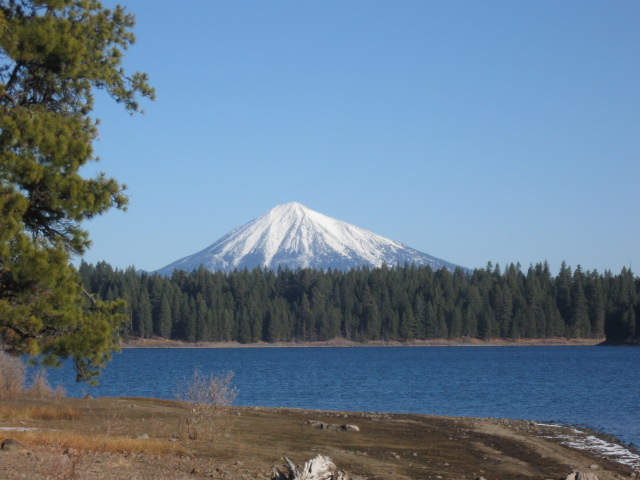Arriving at Lake Apserkaha in the mountains of southern Oregon for a men’s gathering around the theme, “Embracing Climate Change,” I was dismayed, but not shocked to find the lake was actually a pond. The water was nearly a quarter-mile from its normal shoreline at the edge of the forest.
 After picking out a bunk and walking around a bit, I walked down to the lake—as far as I could anyway over the cracked mud and wet, matted grass. Then I sat at the edge of the woods to gaze at Mt. Pitt and the entire expanse below it.
After picking out a bunk and walking around a bit, I walked down to the lake—as far as I could anyway over the cracked mud and wet, matted grass. Then I sat at the edge of the woods to gaze at Mt. Pitt and the entire expanse below it.
It is a man-made lake, carved out of the forest some 70 years ago. Stumps are visible for the first time in decades. The nearly perfectly shaped volcanic cone of barren Mt. Pitt loomed in the distance over the area. I sat at the edge of the woods and let the senses attune to the environment. The place did not inspire.
The image of majestic Mt. Shasta driving north, still surprisingly snow-capped at the end of summer at over 14,000 feet, replayed across the screen of the mind. I had stood transfixed at a rest stop, finding it difficult to leave its shattering presence and return to the road. Now Shasta is but a memory, though one leaving a deep impression on the heart. I’m here, staring at a moonscape.
No method, system or discipline is involved in meditating in nature. One simply ends the observer by passively allowing the senses to attune and awareness to grow quicker than the separative habit of thought, and observing the mind in the mirror of nature until it naturally falls silent. Then there is emptiness, the ground of all being. “In the fire of emptiness the mind is made young, fresh and innocent, and it is innocency alone that can receive the timeless.”
The prevailing view is to meditate in any way that works for you. But that’s false in two ways, first by upholding methods, second by maintaining individualistic approaches to the phenomenon of meditation.
If everyone has their own reality, there is no reality, only chaos. In actuality, there is no such thing as “my stuff;” there’s only stuff.
Every man at the gathering there expressed a sense of sorrow about the lake, and by extension the earth, a feeling that seemed to come from the place itself, and not personal projection.
So it was the next morning it didn’t even occur to me to walk down and look again at the whole scene before the sun rose over the ridge. But converging on the path heading toward the eating area with a cabin mate, the same fellow who was the first person I had a conversation with after arriving the previous afternoon, he said, “You have to go down to the lake; the colors are incredible.”
Immediately changing direction, I found myself staring agape at a scene of unimaginable beauty and splendor. It was not the same place. Mist enshrouded all but the tip of the conical Pitt, and clung to the lake in frozen strands of light as the sun just peeked over the ridge to my right.
Muted shades of blue, gray and yellow flowed together in a panorama of such richness and stillness that I stood agape, unable to move for a few minutes. I once heard a religious teacher say that “God is color,” but I’d never felt the truth of it so clearly as I did that early Saturday morning before the inner work and dialogues of the day began.
I asked myself: What does this beauty have to do with climate change, and with the social dimension, specifically this gathering of a network of men I’d never met or even heard of less than two weeks before?
It is difficult to put into words the deeper things, since by virtue of being the deeper things they are beyond words. And there were things that happened at the gathering at Lake Apserkaha that are inexpressible matters of the heart and the spirit, as well as confidentialities between the men who attended the gathering.
The marine scientist who made the keynote address said his colleagues are much more concerned about “abrupt climate change” than they let on. The consensus of the men there was that climate change poses an unprecedented challenge to humanity, which cannot be addressed solely or firstly at the political level.
A frequent refrain was, “what kind of planet are we leaving our children?” To my surprise, no one disagreed that a revolution in consciousness is required to meet the crisis. What does that mean and how do we bring it about?
Article and Photo by Martin LeFevre

